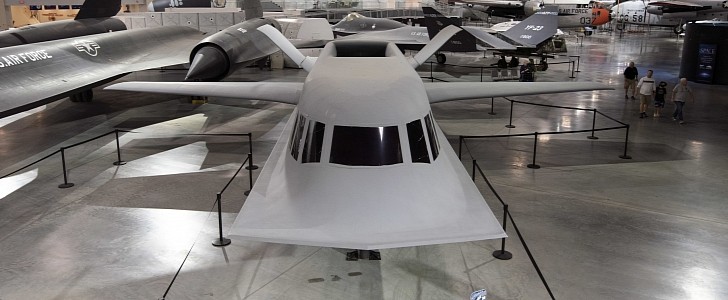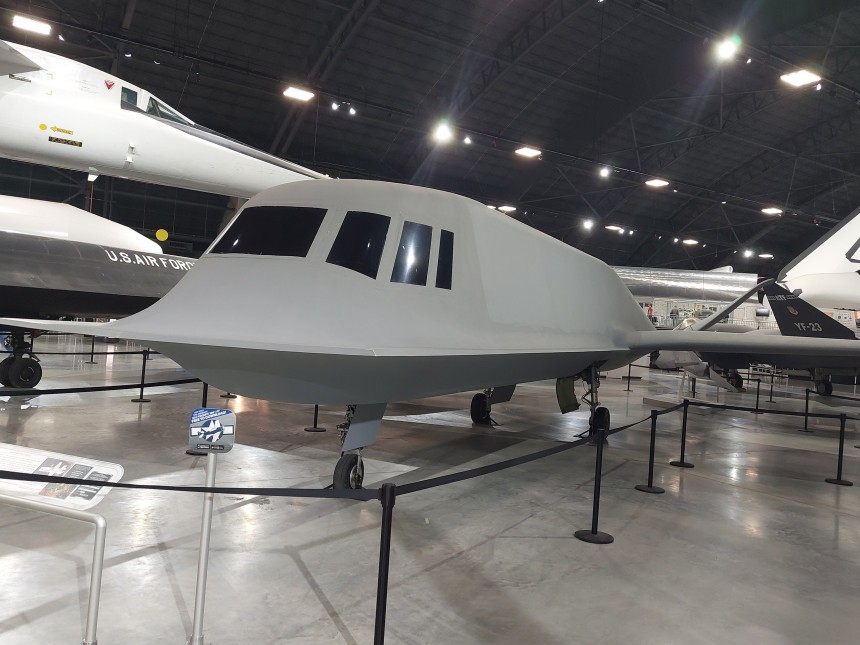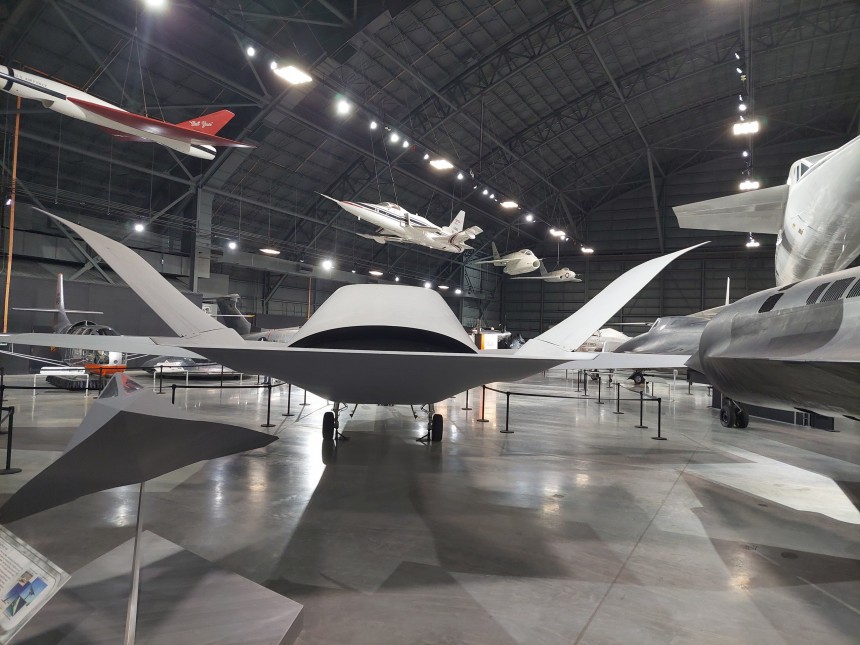Military aircraft are a little bit like sports cars. Form follows function to make something utterly striking, regardless of whether beauty has any tactically relevant advantage. But form must follow function in the armed forces too, even if that means it looks like a third-grader designed it after being picked up from school for wetting themselves.
This is the Northrop Tacit Blue stealth demonstrator, and yes, it's real. On display in the research and development hangar of the National Museum of the United States Air Force, no less. There's some seriously nutty stuff on display in only one of the four main hangars in the Dayton facility, and Tacit Blue is one of its integral exhibits. You're probably wondering why it has a very "specific" set of looks, to put it nicely.
Well, juvenile as the thing seems, there's a very good reason this jet looks the way it does. Stealth was an infant technology in the early 1980s, and the ins and outs of a radar-stealth aircraft were not fully understood at that time. Even as the Lockheed F-117 Nighthawk stealth attack plane took to the skies for the first time, it was unknown if it was possible to build a stealth aircraft that didn't need to look like a black Dorito chip.
This is what Northrop Corporation of California attempted to ascertain with Project Tacit Blue. The company had relative success with stealth technology, having developed the B-2 Spirit before a merger with Grumman Aerospace turned it into Northrop Grumman in the mid-90s. As an aircraft with the aerodynamic qualities of a psychedelic mushroom-induced hallucination, the Tacit Blue utilized a computerized fly-by-wire system to keep the plane aloft at altitude.
That, of course, meant the thing would fall out of the sky like a brick if the system failed. But the technology would become vital as many other aircraft began to utilize it further into the 80s and 90s. Work first began on the project under the U.S. Air Force's Battlefield Surveillance Aircraft-Experimental (BSAX) program in 1976.
The craft was ready to fly by February 1982. Its first flight took place in February of that year. Jack Cashen, the chief engineer of Northrop's stealth bomber B2, called Tacit Blue, "the most unstable aircraft man had ever flown." For better or worse, the aircraft was powered by two Garrett ATF3-6 turbofan engines with 5,440 lbs (24.2 kN) of thrust per side. Good for around 250 knots (290 mph, 460 km/h) on the high end.
Granted, Tacit Blue was never supposed to be much other than a stealth demonstrator. So there was little point in fitting the jet with more powerful engines or mounting a couple of missiles and cannons. Tacit Blue proved more than anything that there was more than only one way of making an aircraft "stealthy." Ultimately learning the tapered-winged, v-tailed "alien school bus" wasn't as useless at reflecting radar beams as first thought.
Only one example was ever produced, but it's said that Northrop had the ability to have another up and running if the original were to be lost in some accident. The interior of Project Tacit Blue's cockpit is far more mundane than the exterior. Many components like the flight stick and instrument panel dials are seemingly borrowed from the Northrop projects like the F-5 Freedom fighter.
Museum staff often joke that Tacit Blue's top-mounted air intake looks like a whale's blowhole as it skimmed along at 30,000 feet. The plane completed more than 130 hours of test flights over three years until 1985. It was then mothballed in Air Force reserve storage until the project was declassified in 1996. It has called the museum home ever since.
Today, the aircraft wows visitors the same way it did military personnel back in the mid-80s. All it needs is an 80s vintage IROC-Z Camaro and a man with a mullet in the cockpit to complete a throwback look we don't think anyone alive on Earth is truly ready for.
Tacit Blue has to be the hands-down strangest-looking thing this side of a Pontiac Aztek with the tent accessory. At least you can find an Aztek for a few thousand dollars these days. The Tacit Blue program was at least a nine or ten-figure military program, and this is the only one made. Who wins that battle? No one, that's who.
Well, juvenile as the thing seems, there's a very good reason this jet looks the way it does. Stealth was an infant technology in the early 1980s, and the ins and outs of a radar-stealth aircraft were not fully understood at that time. Even as the Lockheed F-117 Nighthawk stealth attack plane took to the skies for the first time, it was unknown if it was possible to build a stealth aircraft that didn't need to look like a black Dorito chip.
This is what Northrop Corporation of California attempted to ascertain with Project Tacit Blue. The company had relative success with stealth technology, having developed the B-2 Spirit before a merger with Grumman Aerospace turned it into Northrop Grumman in the mid-90s. As an aircraft with the aerodynamic qualities of a psychedelic mushroom-induced hallucination, the Tacit Blue utilized a computerized fly-by-wire system to keep the plane aloft at altitude.
That, of course, meant the thing would fall out of the sky like a brick if the system failed. But the technology would become vital as many other aircraft began to utilize it further into the 80s and 90s. Work first began on the project under the U.S. Air Force's Battlefield Surveillance Aircraft-Experimental (BSAX) program in 1976.
Granted, Tacit Blue was never supposed to be much other than a stealth demonstrator. So there was little point in fitting the jet with more powerful engines or mounting a couple of missiles and cannons. Tacit Blue proved more than anything that there was more than only one way of making an aircraft "stealthy." Ultimately learning the tapered-winged, v-tailed "alien school bus" wasn't as useless at reflecting radar beams as first thought.
Only one example was ever produced, but it's said that Northrop had the ability to have another up and running if the original were to be lost in some accident. The interior of Project Tacit Blue's cockpit is far more mundane than the exterior. Many components like the flight stick and instrument panel dials are seemingly borrowed from the Northrop projects like the F-5 Freedom fighter.
Museum staff often joke that Tacit Blue's top-mounted air intake looks like a whale's blowhole as it skimmed along at 30,000 feet. The plane completed more than 130 hours of test flights over three years until 1985. It was then mothballed in Air Force reserve storage until the project was declassified in 1996. It has called the museum home ever since.
Today, the aircraft wows visitors the same way it did military personnel back in the mid-80s. All it needs is an 80s vintage IROC-Z Camaro and a man with a mullet in the cockpit to complete a throwback look we don't think anyone alive on Earth is truly ready for.












